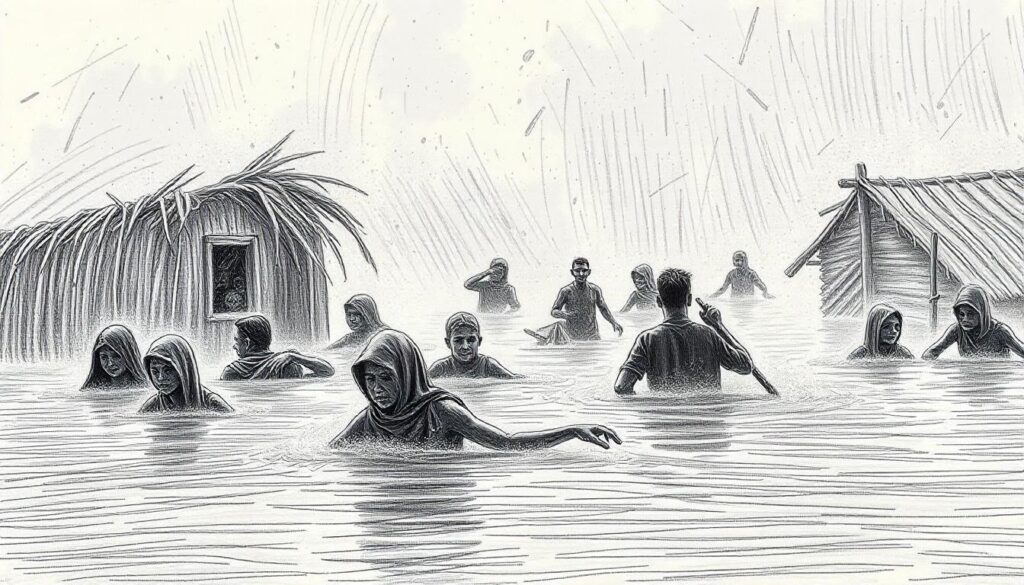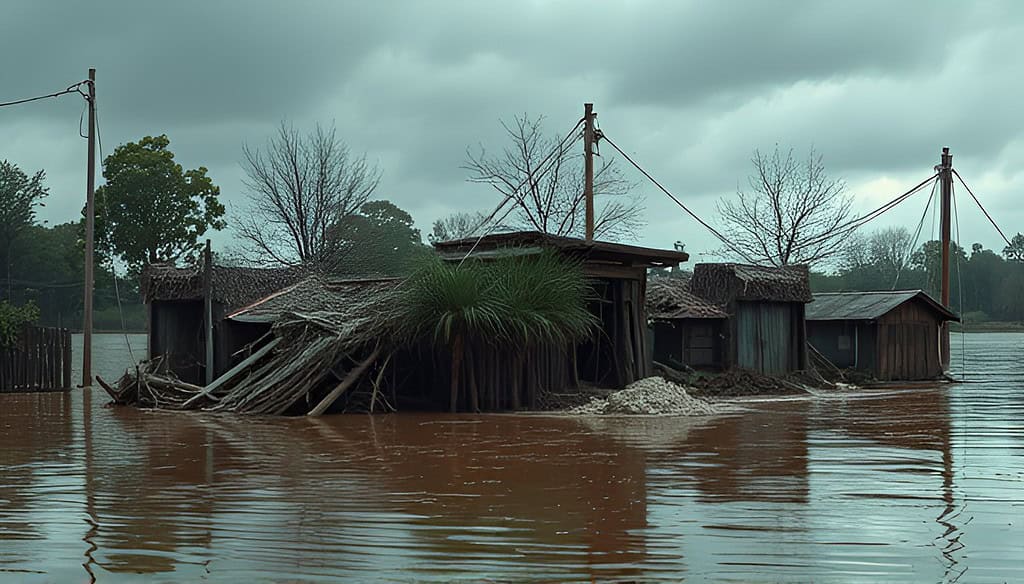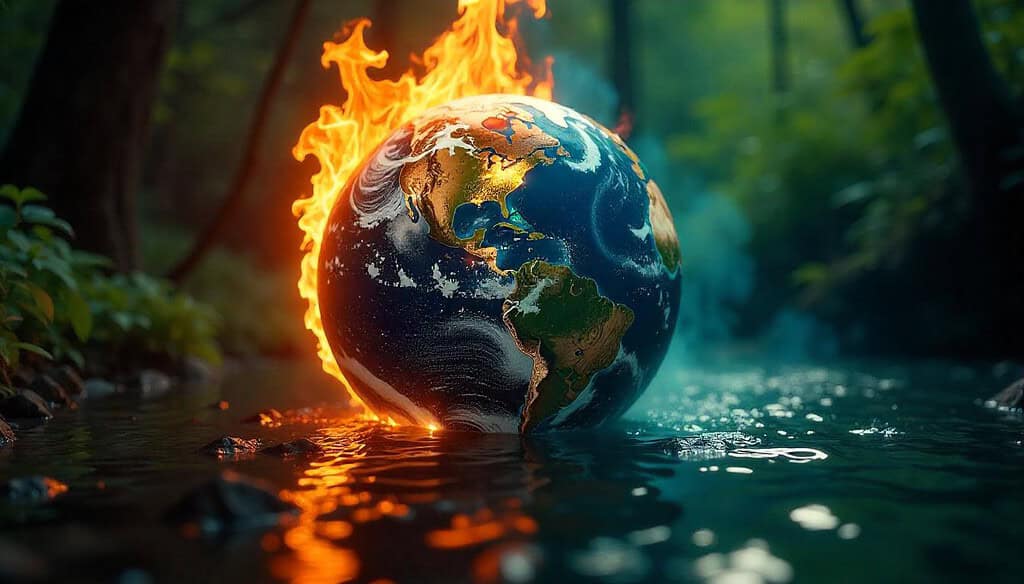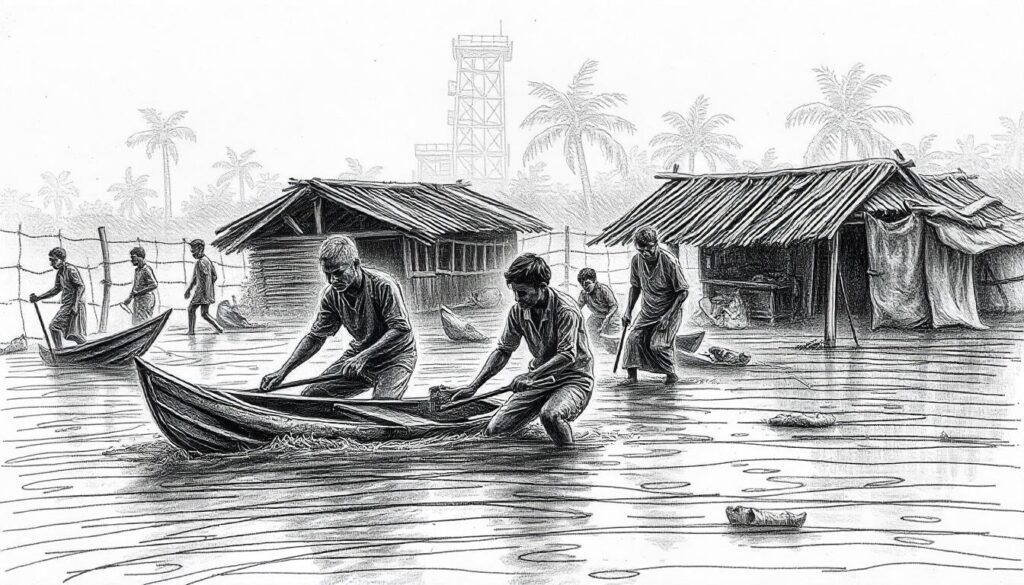Table of Contents
Global Climate Change and The Impoverished

Global Climate Change refers to long-term shifts and alterations in temperature, weather patterns, and atmospheric conditions primarily driven by human activities, such as burning fossil fuels and deforestation. As greenhouse gases accumulate in the atmosphere, they trap heat, leading to rising temperatures and erratic weather patterns. While climate change has occurred throughout Earth’s history, the current pace and intensity are unprecedented due to human influence, creating serious consequences for the planet and its inhabitants.
One of the most significant impacts of Global Climate Change is its wide-ranging effects on ecosystems, economies, and societies. Melting polar ice caps and glaciers contribute to rising sea levels, threatening coastal cities and island nations with increased flooding. Changes in precipitation patterns lead to more frequent and severe storms, droughts, and wildfires, disrupting agriculture and water supplies. Warmer temperatures also contribute to the spread of diseases as certain pathogens and pests thrive in the changing climate, threatening human health. Additionally, the loss of biodiversity due to habitat destruction and ecosystem collapse impacts food chains and natural resources, which can destabilize entire regions.
Despite its global impact, Global Climate Change disproportionately harms the world’s impoverished populations. These communities often live in vulnerable areas with limited resources, making it harder for them to adapt to the changing climate. For instance, many impoverished people reside in low-lying regions or informal settlements that are particularly susceptible to flooding or coastal erosion. As sea levels rise, these populations face displacement and loss of homes, with little to no access to financial support for relocation or recovery.
Moreover, the economic instability caused by Global Climate Change hits the poor hardest. Droughts, crop failures, and extreme weather events disrupt food production, leading to higher prices for basic necessities like food and water. Impoverished communities, which already spend a large proportion of their income on essential goods, suffer from this economic pressure. In rural areas where agriculture is a primary source of income, entire livelihoods can be lost as farming becomes more difficult or impossible in a changing climate. Without adequate access to technology, infrastructure, or government assistance, these communities find it challenging to recover from environmental shocks.
Health is another area where Global Climate Change leaves its most damaging effects on the impoverished. Poor communities often lack access to proper healthcare, clean water, and sanitation, making them more vulnerable to the spread of diseases that thrive in warmer conditions, such as malaria or cholera. As extreme weather events increase in frequency, healthcare systems in these regions can become overwhelmed, leaving people with even fewer options for treatment and protection.
In essence, while Global Climate Change threatens the entire planet, it is the poorest people who suffer the most. Their limited resources and vulnerability to environmental and economic shocks make them less able to cope with the devastating effects of climate change. Addressing this issue requires not only mitigating the causes of climate change but also focusing on protecting and supporting those who are least equipped to deal with its impacts.
Global Climate Change: 8 Worst Ways It Hurts The Impoverished

1. Increased Risk of Natural Disasters
Global Climate Change significantly amplifies the frequency and intensity of natural disasters, disproportionately affecting impoverished populations. As the climate warms, extreme weather events such as hurricanes, floods, and droughts become more severe. Impoverished communities are often located in vulnerable areas like coastal regions, floodplains, or drought-prone zones, where they are more exposed to these disasters.
With limited resources and infrastructure, these populations are ill-prepared to withstand or recover from the devastation caused by climate-driven events. Homes built with inadequate materials or in unstable areas are more likely to be destroyed, leaving families displaced and struggling to rebuild. Additionally, impoverished areas often lack proper early warning systems, disaster relief programs, and access to insurance, making recovery slow and difficult.
Global Climate Change also contributes to secondary effects, such as landslides and soil erosion, which further exacerbate the living conditions of those affected. The cycle of destruction and rebuilding traps many impoverished people in a continuous state of vulnerability, where any progress is easily wiped out by the next disaster. Global Climate Change not only increases the number of extreme weather events but also deepens the hardships faced by those least able to recover from them. Without global action to mitigate these climate effects, natural disasters will continue to disproportionately impact the world’s poorest populations, reinforcing existing inequalities and making it nearly impossible for them to escape poverty.
2. Food Insecurity
Food insecurity is one of the most pressing challenges that Global Climate Change brings to impoverished populations. As global temperatures rise, changing weather patterns disrupt traditional agricultural cycles, leading to reduced crop yields and lower food production. Many impoverished communities rely heavily on subsistence farming or local agriculture for their food supply and livelihoods. When extreme weather events such as droughts, floods, or heatwaves occur, they devastate crops and livestock, leaving communities without sufficient food to eat or sell.
Global Climate Change also alters the timing and distribution of rainfall, causing either excessive droughts or unpredictable flooding, both of which are harmful to agriculture. This results in reduced harvests and drives up the cost of food, making basic necessities less affordable for impoverished people who already struggle to meet their daily needs. As food prices soar, hunger and malnutrition become more widespread, particularly among children, who suffer long-term developmental consequences.
Global Climate Change also affects fisheries, a key source of food and income for many coastal communities. As ocean temperatures rise and ecosystems are disrupted, fish populations decline, leading to further food shortages. The combined effects of climate change-induced agricultural and fishery declines push impoverished populations deeper into food insecurity. Without the means to adapt, many communities face ongoing cycles of hunger and poverty as Global Climate Change continues to affect their ability to grow, buy, and access food.
3. Water Scarcity
Water scarcity is another critical issue exacerbated by Global Climate Change, especially for impoverished populations. As temperatures rise and weather patterns shift, many regions experience reduced rainfall and prolonged droughts, making access to clean and sufficient water increasingly difficult. Impoverished communities often depend on natural water sources like rivers, lakes, and wells, which are vulnerable to the effects of Global Climate Change. When droughts occur, these water supplies dry up, leaving communities with limited or no access to water for drinking, sanitation, and agriculture. Even in regions where rainfall remains consistent, Global Climate Change can disrupt the timing and distribution of precipitation, causing unpredictable water availability.
The lack of proper infrastructure, such as pipelines, reservoirs, or water treatment facilities, means that impoverished populations are often forced to rely on contaminated or unsafe water sources, increasing the risk of waterborne diseases. Additionally, competition for dwindling water resources can lead to conflict between communities, further aggravating the hardships faced by the poor. In agricultural regions, water scarcity negatively impacts crop irrigation, reducing yields and contributing to food insecurity.
Global Climate Change intensifies the challenge of water management, especially in areas where governments lack the capacity to implement effective solutions. Without access to clean water, impoverished communities are trapped in a cycle of deprivation, where health, food security, and overall well-being are constantly at risk. Global Climate Change continues to worsen water scarcity, leaving the world’s poorest populations more vulnerable to its long-term consequences.
4. Health Impacts
Global Climate Change has profound effects on human health, with impoverished populations bearing the brunt of the consequences. As the planet warms, conditions become more favorable for the spread of diseases such as malaria, dengue fever, and cholera, particularly in tropical and subtropical regions. Impoverished communities often lack access to adequate healthcare, clean water, and sanitation facilities, making them more vulnerable to these diseases.
Warmer temperatures create ideal conditions for disease-carrying insects, such as mosquitoes, to thrive, increasing the likelihood of outbreaks. The spread of these diseases is further exacerbated by the lack of medical infrastructure in impoverished regions, where health services are often underfunded and understaffed. Global Climate Change also contributes to respiratory issues, as increased air pollution and heat waves lead to higher rates of asthma and other respiratory conditions. In many impoverished urban areas, where pollution levels are already high due to industrial activity and poor environmental regulations, the effects of rising temperatures compound existing health problems.
Extreme weather events, such as floods and hurricanes, also lead to public health crises by contaminating water supplies, causing injuries, and displacing people into overcrowded conditions where diseases spread more easily. In the aftermath of such disasters, the poor often struggle to access medical care, vaccines, or even basic necessities like clean water, further putting their health at risk.
Malnutrition, too, is a significant concern, as Global Climate Change disrupts food production and increases food prices. The lack of adequate nutrition weakens immune systems, particularly in children, leaving them more susceptible to illness. For impoverished communities, the health impacts of Global Climate Change are not only immediate but also long-term, as chronic diseases and malnutrition take a lasting toll on overall well-being and quality of life. Addressing the health consequences of Global Climate Change requires urgent attention, particularly for those who lack the resources to protect themselves.
5. Displacement and Migration
Displacement and migration are among the most severe consequences of Global Climate Change, affecting millions of impoverished people worldwide. As sea levels rise, coastal communities face the threat of losing their homes and livelihoods, forcing them to relocate. Many of these communities are already economically disadvantaged and lack the resources to move to safer areas. The destruction of homes and infrastructure by floods, hurricanes, and other climate-related disasters leaves people homeless and without access to basic services.
Global Climate Change also exacerbates desertification in some regions, making once fertile lands barren and uninhabitable. In rural areas, where agriculture is a primary source of income, families are forced to leave their homes in search of more fertile land or alternative livelihoods. This mass displacement often leads to overcrowding in urban areas, where impoverished migrants struggle to find affordable housing, employment, or access to public services.
The migration caused by Global Climate Change also leads to conflict and competition over resources in host communities. As more people move into cities or across borders, tensions arise over the allocation of limited resources, such as water, food, and housing. In some cases, migration leads to political instability, as governments fail to adequately support displaced populations. The emotional and psychological toll on displaced individuals is immense, as they face the trauma of losing their homes, livelihoods, and sense of community.
Furthermore, many displaced people are forced into informal settlements or refugee camps, where living conditions are often dire. These environments, which lack proper sanitation, healthcare, and infrastructure, leave people vulnerable to disease and further hardship. Global Climate Change continues to displace vulnerable populations at an alarming rate, with little indication of respite. The impoverished, who are least equipped to handle such upheaval, suffer the most, as they are pushed into increasingly precarious living situations.
6. Loss of Livelihoods
Global Climate Change has a devastating impact on livelihoods, particularly for those living in poverty. Many impoverished populations rely on agriculture, fishing, or natural resources for their income. However, as climate patterns shift, these traditional ways of life become increasingly difficult to sustain. Rising temperatures, altered rainfall patterns, and more frequent droughts reduce agricultural productivity, making it harder for small-scale farmers to grow crops or rear livestock.
In regions already prone to drought, the effects of Global Climate Change further exacerbate water shortages, making farming unsustainable. This loss of income forces many rural families into deeper poverty, as they struggle to adapt to the changing environment without access to modern farming techniques or resources. Global Climate Change also affects fisheries, as warming oceans disrupt marine ecosystems and cause fish populations to decline. Coastal communities that depend on fishing for their livelihood find themselves with diminishing catches and fewer economic opportunities.
In addition to agriculture and fishing, Global Climate Change threatens industries such as tourism and forestry, which provide jobs for many in impoverished regions. As natural landscapes are altered or destroyed by climate-driven events such as wildfires, floods, and deforestation, the loss of these environments reduces employment opportunities in these sectors. Impoverished workers often lack the skills or financial resources to transition to other forms of employment, leaving them without viable alternatives. The loss of livelihoods leads to a cycle of poverty that is difficult to break, as people become increasingly dependent on shrinking natural resources.
Without economic security, impoverished communities are less able to adapt to the changing climate, creating a vicious cycle of vulnerability. Global Climate Change not only destroys the livelihoods of the poor but also diminishes their ability to recover, as the resources and support needed to rebuild are often unavailable to them. Addressing these challenges requires targeted efforts to help vulnerable communities adapt to the new climate realities and secure alternative sources of income.
7. Energy Poverty
Energy poverty is one of the critical issues exacerbated by Global Climate Change, particularly affecting impoverished communities. As the world faces more frequent extreme weather events and shifting climate patterns, access to reliable and affordable energy becomes increasingly vital for survival and development. However, impoverished populations, especially in rural and developing areas, often have limited access to electricity or clean energy sources. Many rely on traditional fuels such as wood, charcoal, or kerosene, which not only contribute to environmental degradation but also pose significant health risks. The lack of access to modern energy sources hinders economic growth, education, and healthcare, trapping communities in cycles of poverty.
Global Climate Change worsens energy poverty in several ways. Extreme weather events like hurricanes and floods can damage energy infrastructure, cutting off electricity to vulnerable areas. Rising temperatures also increase the demand for energy, especially for cooling, but impoverished communities often cannot afford air conditioning or even electric fans. This leaves them particularly exposed to heatwaves, which can cause heat-related illnesses and even death. Furthermore, Global Climate Change affects the availability and affordability of renewable energy sources. For instance, changing weather patterns may disrupt solar and wind energy production, making it harder for impoverished areas to transition to cleaner, more sustainable power sources.
Energy poverty also limits the ability of impoverished communities to adapt to Global Climate Change. Without electricity, they cannot power irrigation systems, water pumps, or communication devices that could help them cope with climate-related challenges. The absence of reliable energy access also restricts economic opportunities, as businesses and schools require power to function. To address energy poverty, it is crucial to invest in resilient and sustainable energy infrastructure, particularly in regions most affected by Global Climate Change. By improving energy access, these communities can enhance their resilience and reduce their vulnerability to the ongoing impacts of climate change.
8. Exacerbation of Inequality
Global Climate Change not only affects the environment but also worsens existing social and economic inequalities. The impacts of climate change are not distributed evenly; instead, they disproportionately affect the world’s poorest and most vulnerable populations. While wealthier nations and individuals have the resources to protect themselves and adapt to changing conditions, impoverished communities lack the financial means, infrastructure, and support to do so. This unequal burden deepens the gap between rich and poor, both within countries and on a global scale. As a result, Global Climate Change becomes a significant driver of inequality, perpetuating a cycle where the poorest bear the heaviest costs.
In wealthier countries, advanced technologies and well-funded disaster preparedness systems help mitigate the effects of climate change. These countries can afford to build seawalls, upgrade infrastructure, and develop early warning systems for extreme weather events. In contrast, impoverished regions often lack the financial capacity to implement such measures. When disasters strike, the poor suffer greater losses and have fewer resources to recover. Global Climate Change also exacerbates inequality through its impact on agriculture, water access, and health. Wealthier individuals can afford rising food prices or secure private healthcare, while impoverished populations struggle to meet basic needs as the effects of climate change worsen.
The global response to climate change further reflects and reinforces these inequalities. Developed nations, which have historically contributed the most to Global Climate Change through industrial activities, are better positioned to adapt. Meanwhile, developing nations, which have contributed the least to the problem, are hit hardest by its effects. This global imbalance highlights the ethical dimensions of the climate crisis, as those who are least responsible for causing it face the greatest consequences. To address the exacerbation of inequality, international cooperation is essential to ensure that the poorest communities receive the support and resources needed to adapt to the impacts of Global Climate Change.
Global Climate Change: Lessening The Burden of The Impoverished

Lessening the burden of impoverished populations affected by Global Climate Change requires a multifaceted approach that addresses both immediate needs and long-term challenges. One of the most critical steps is investing in resilient infrastructure, especially in regions that are most vulnerable to extreme weather events. Strengthening homes, schools, and hospitals to withstand floods, hurricanes, and heatwaves can significantly reduce the loss of life and property during climate-related disasters.
Moreover, building climate-resilient infrastructure ensures that communities can recover faster and are less likely to be trapped in cycles of poverty after such events. In rural areas, constructing irrigation systems that rely on renewable energy sources like solar power can help farmers maintain agricultural productivity even as rainfall becomes more erratic due to Global Climate Change. Such systems not only improve food security but also provide a sustainable means of livelihood for impoverished populations.
In addition to infrastructure, improving access to education and information about climate adaptation is crucial. Many impoverished communities lack the knowledge and tools necessary to cope with the impacts of Worldwide Climate Change. Education programs that focus on sustainable farming techniques, water conservation, and disaster preparedness can empower individuals to take proactive steps in safeguarding their livelihoods. Additionally, these programs should emphasize gender equity, as women in impoverished regions are often disproportionately affected by climate change and are key contributors to food production and resource management. When communities are equipped with the right knowledge and skills, they are better able to adapt to shifting environmental conditions and reduce their vulnerability to climate shocks.
Another vital strategy for lessening the burden on the impoverished is increasing financial support and social safety nets. Governments and international organizations must provide targeted financial aid to help communities recover from climate-related disasters and rebuild their lives. This could include direct cash transfers, low-interest loans, or grants to help families rebuild homes, restart businesses, or invest in climate-resilient practices.
Additionally, governments need to strengthen social safety nets, such as unemployment benefits or food assistance, to ensure that those affected by climate-related disruptions do not fall deeper into poverty. Access to affordable health care is equally important, as impoverished populations are more susceptible to climate-related diseases. Providing universal healthcare or affordable medical services can reduce the health burdens that arise from worsening environmental conditions, helping communities remain resilient.
Furthermore, renewable energy initiatives are key to addressing the twin challenges of energy poverty and Global Climate Change. Expanding access to affordable, clean energy sources such as solar and wind power can reduce reliance on harmful, polluting fuels while also creating job opportunities in green industries. For impoverished populations, access to renewable energy not only improves daily living conditions but also allows them to participate in the growing green economy. Governments and private sectors should work together to develop programs that subsidize renewable energy technologies for low-income households and provide training for jobs in these industries. This approach not only addresses immediate energy needs but also helps to mitigate climate change by reducing carbon emissions.
Finally, international cooperation and climate justice must be at the heart of any solution. Wealthier nations, which have contributed the most to Global warming and Climate Change, have a moral responsibility to provide financial and technical assistance to developing countries that are bearing the brunt of its effects. This can take the form of funding for climate adaptation projects, technology transfers to build sustainable infrastructure, and debt relief to allow impoverished nations to focus on climate resilience rather than servicing debt. By embracing a fair and equitable approach to climate action, the global community can help lessen the burden of Global Climate Change on the world’s most vulnerable populations.
Global Climate Change: Way Forward is To Stop It

The way forward in addressing the crisis of Global Climate Change is clear: the best way to stop it is to stop it, and this demands serious global commitment. Half measures and delays only worsen the situation, leading us toward an irreversible catastrophe. We must take decisive steps on a global scale to curb greenhouse gas emissions, shift to renewable energy, and transform our economies into sustainable ones.
Nations must unite in their efforts to implement stringent environmental policies, drastically reduce carbon footprints, and transition from fossil fuels to cleaner energy alternatives. Global Climate Change cannot be effectively addressed by individual nations acting alone. It requires coordinated action, international agreements, and a collective commitment to meet ambitious climate goals.
If we fail to stop the worsening Climate Change in the near future, the consequences will be catastrophic, particularly for the world’s impoverished populations. They are the least equipped to handle extreme weather, food shortages, and rising sea levels, which will inevitably occur as the planet continues to warm. The disproportionate impact on the poor will deepen existing inequalities, further destabilizing vulnerable communities across the globe. As such, urgent global intervention is not just a matter of environmental preservation but also one of social justice.
The way forward demands immediate and large-scale action from governments, businesses, and individuals alike. We must prioritize sustainability, invest in clean technologies, and support vulnerable nations in adapting to the changing climate. Without this unified approach, the impacts of Global Climate Change will be severe and far-reaching, threatening both the planet and its most disadvantaged inhabitants. Now is the time to act, before the window of opportunity closes and the damage becomes too great to reverse.
Disclaimers: *This article is only for informational purposes.
**Do not make your important decisions based solely on the information provided in this article. Do your own research.
***Information in this article may vary or may get updated in the future.
Read More Science and Space Articles
- Danger Of Environmental Damage: 8 Ways A Person Can Help
- Eradication Of Poverty: 8 Critical Ways Science Helps
- Japan’s Space Program: Top 8 Incredible Achievements By It
- STEM Fields: 8 Important Reasons Why You Must Learn Them
- Making Your Kid Efficient At STEM Subjects: 8 Important Steps
- Making Your Kid Science Enthusiast: 8 Important Steps
- Becoming A NASA Aspirant: 8 Important Steps You Must Follow
- Top 4 Colored Rice That Are Superior to White Rice
- Top 8 Important Wellness Habits That You Must Follow
- Top 5 Amazing Whole Grains That Are Healthier Than Rice
- Indian Space Program: 8 Incredible Achievements
- China’s Space Program: 5 Amazing Accomplishments
- Oranges: 11 Incredible Facts About This Tangy Citrus Fruit
- NASA’s MOXIE Creates O2: Big Step Towards Mars Colonization
- Top 5 Amazing Properties of Time That Defy Common Sense
- 10 Factors for Emergence of Intelligent Life in The Universe
- Space Science: 6 Vital Reasons Why We Should Invest in It
- Solar System: 10 Astonishing Uniqueness of our star system
- Our Universe: An Incredible Journey of 13.7 Billion Years
- Top 6 Solar System Objects That Might Destroy Life On Earth
- Certain End of The Universe: 4 Forces of Nature to Watch Out For
- Big Bang: An Incredible Start of Universe 14 Billion Years Ago




